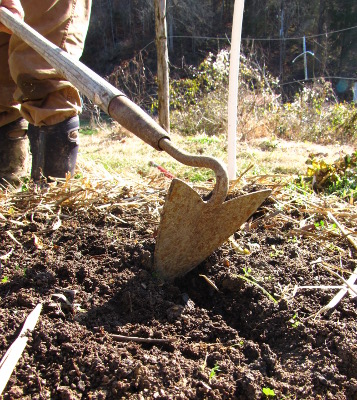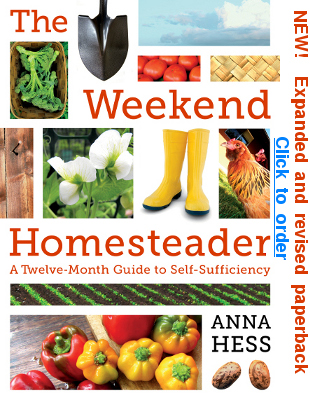
How to plant a no-till garden
 Planting spring crops is
extremely easy in a no-till garden. If
you haven't already done so, rake back the mulch and add half an inch
to an inch of high quality compost to feed your vegetables. For
best results, you'll want to work the compost into the top inch or two
of your soil with a bow rake, but don't disturb the soil profile
further down.
Planting spring crops is
extremely easy in a no-till garden. If
you haven't already done so, rake back the mulch and add half an inch
to an inch of high quality compost to feed your vegetables. For
best results, you'll want to work the compost into the top inch or two
of your soil with a bow rake, but don't disturb the soil profile
further down.
Small seeds can be
scattered directly on the soil surface in damp
spring weather. Larger seeds (like peas) and seed potatoes should
be planted in a trench made by dragging your hoe in a line down the
length of the bed. Add your seeds then fill the trench back in,
lightly tamping the soil with the flat part of your hoe to remove air
pockets. Your seed packet will tell you how deep to plant your
seeds, but a good rule of thumb is that depth should be proportional to
size of the seed --- miniscule seeds can go on the soil surface,
medium-sized seeds might sit a quarter of an inch below, while large
seeds can be planted an inch or more deep.
 As long as you pay
attention to soil temperature, germination shouldn't
be a problem in the spring. Once your seedlings are up and
running, weed carefully then mulch to prevent further weeds from
growing. Now all you have to do is watch and wait for April, May,
and June vegetables.
As long as you pay
attention to soil temperature, germination shouldn't
be a problem in the spring. Once your seedlings are up and
running, weed carefully then mulch to prevent further weeds from
growing. Now all you have to do is watch and wait for April, May,
and June vegetables.
This
week's lunchtime series is
excerpted from Weekend
Homesteader: March. I saved some of my favorite
projects for last, so I hope you'll splurge 99 cents to read about
growing edible mushrooms, composting, and attracting native
pollinators. And, of course, the ebook has the full spring
planting
chapter.
| This post is part of our Spring Planting lunchtime series.
Read all of the entries: |
Want more in-depth information? Browse through our books.
Or explore more posts by date or by subject.
About us: Anna Hess and Mark Hamilton spent over a decade living self-sufficiently in the mountains of Virginia before moving north to start over from scratch in the foothills of Ohio. They've experimented with permaculture, no-till gardening, trailersteading, home-based microbusinesses and much more, writing about their adventures in both blogs and books.
Want to be notified when new comments are posted on this page? Click on the RSS button after you add a comment to subscribe to the comment feed, or simply check the box beside "email replies to me" while writing your comment.

Some folks do presprout their spring seeds, and it can work well as long as you set them out very carefully so you don't break their roots or sprouts. I'll be curious to hear how your presprout goes!
If you put them in pots inside, you'll be able to harden them off so they don't get shocked --- put them outside for a few days, but take them in at night at first.